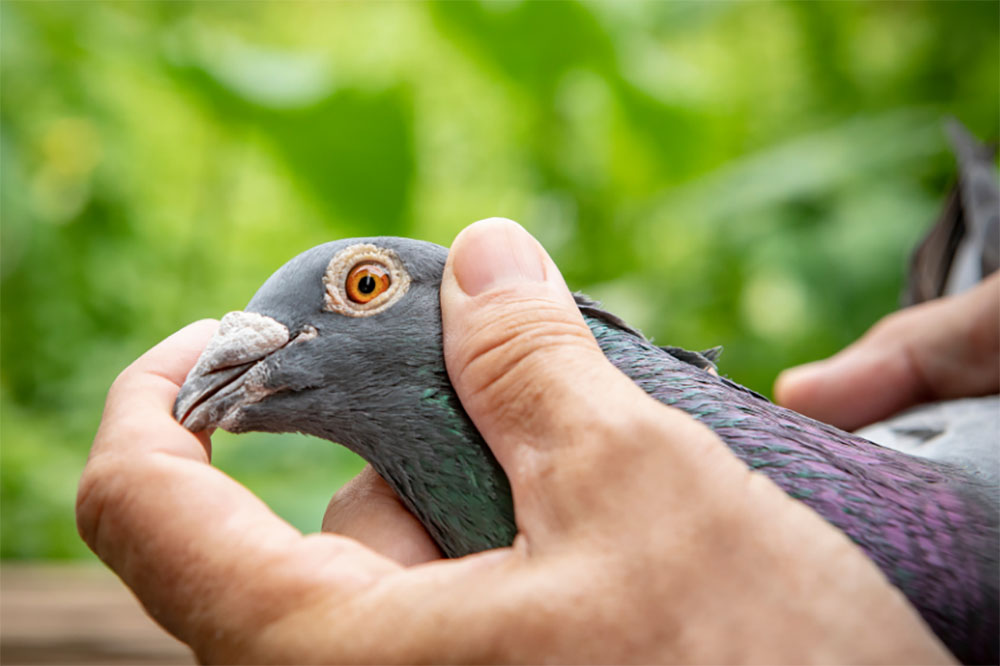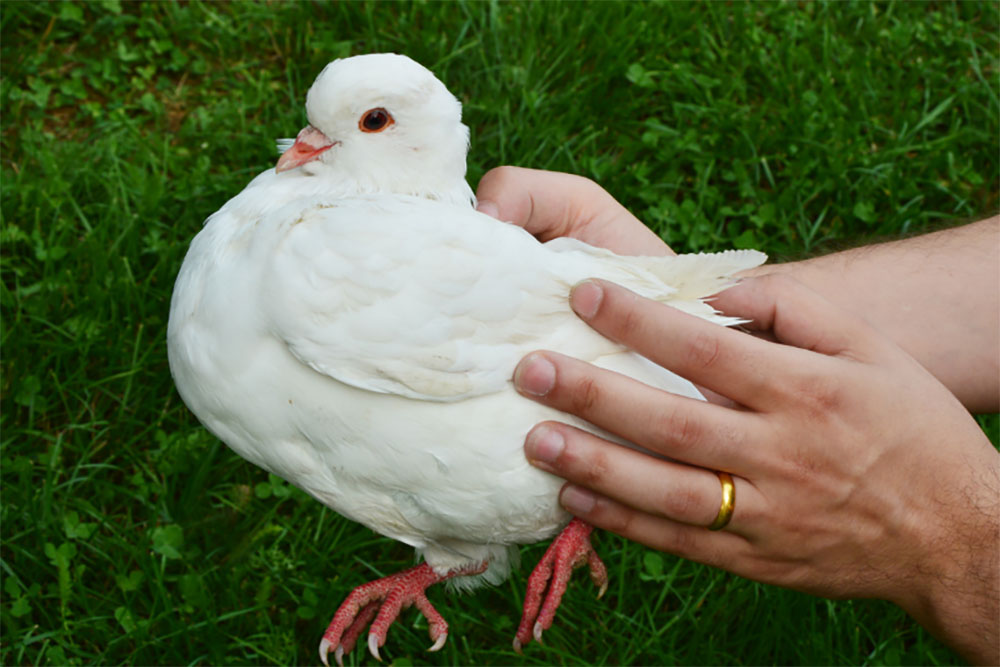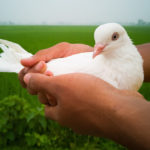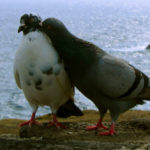Here’s the thing. Your day-to-day to-do list includes lots of things.
Get coffee. Finish that piece of work by the deadline. Respond to emails. Catch up with friends.
Unless you work at a shelter – and we’re betting you don’t – it would take a superhuman amount of foresight to include “Rescue a pigeon or dove” on your to-do list.

But, because of the way industries like pigeon racing and dove releases work, you may on any given day find yourself in a position where you find a pigeon or a dove that’s in pain, in distress, or seriously disoriented and malnourished.
It may be wounded by predators, it may be injured by circumstances.
And suddenly, you face a fundamental test of human ethics.
You could a) walk away from the bird and carry on your day as normal, somewhat haunted by the disoriented “Why did this happen to me?” look in the otherwise expressionless eyes.
Or you could b) accept that on this day, for whatever reason, the universe has handed you a bird in need of rescue, and that that’s what your day is about now.
A couple of hard facts for you before you make your choice.
#1 – pigeon racers and dove release companies care practically not at all for the pigeons that don’t win their races or doves that get lost, so it’s very unlikely the original owners of the pigeon or will either want them back, or will be of any help in rescuing them – especially financially. And
#2 – if you walk away and leave the bird, it will almost certainly die. It’s been domestically raised and lacks every single survival skill it would need to live long in the wild. If you walk away, what you have there is pretty much a McPigeon sandwich – a handy morsel for the first predator that comes along. And they will.
No pressure…
We began by saying nobody’s day includes rescuing a pigeon or a dove – until it does. And that’s the point. We understand.
No-one necessarily knows how to rescue a pigeon or dove – but the practices of pigeon raising for sport and dove breeding for romantic or celebratory release means the country is practically awash with lost, disoriented, malnourished birds at any given time, just waiting to be picked off by predators – unless a kindly human steps in.
But steps in how?
We’ve got you covered.
- Fact #1 – you can do this. Honestly, you can. We know you didn’t plan on it, but it’s well within your capabilities.
- Fact #2 – if you follow some basic principles, you’re not about to scare the pigeon or the dove to death by handling it, and it will – beyond all shadow of doubt – be better off being found by you than it would be if it were found by any of the many things that want to eat it.
- Fact #3 – the pigeon or dove is not about to hurt you either. We know the thinking – claws, beak, pestilential mites or mange, eww!
- Relax. Realistically, the number of diseases that can transfer from pigeons to humans is smaller than the number that can transfer from dogs to humans, and those diseases don’t stop you cuddling up to Fido, right? Even more pertinently, pigeon beaks are soft, rather than hard. A pigeon pecking frenzy is almost laughable to imagine – it’s like being gummed to death by a newborn baby. These are not birds of prey. If they were in an animated movie, they’d be the cute-but-stupid one who all the kids want cuddly toys of.
So, with these facts firmly under our belts – how the heck are we rescuing that pigeon?
Now, a disclaimer. In line with the cute-but-stupid way we’ve mischaracterized the birds, they are of course not going to know you mean them no harm.
That means they’re likely to try and make it as difficult as possible for you to catch them, hold onto them, and in any practical way, rescue them.
Until a certain understanding is established between you and the bird, it’s likely to view you as an apex predator.
To be fair, this makes sense given that almost everything in the wild will likely be trying to kill a domesticated pigeon or dove that’s out of its comfort zone.
And also, it’s fair to say Humanity has form as an apex predator to small fluttery things with a certain plumpness and a reasonably high protein content.
So, it’s worth going into the whole experience of pigeon-rescuing with at least some sense of a pigeon’s-eye-view of the experience.
Method #1 – The Scoop
Here’s a thing. This is not some wild-eyed desperado city bird you’re dealing with.
This is a bird that’s been raised domestically, traditionally fed by humans, cooped by humans, probably banded by humans.

Perversely, you might find it’s more comfortable around humans than it is around any of the wilder predators it has encountered since its life took a mighty wrong turn.
So, you could try just scooping it up in your hands or arms.
Sounds mad – works more often than you’d ever imagine. Again, cute-but-stupid – sometimes, domestically bred pigeons or doves have yet to forget their domesticated routines and will let you do it.
That said, even domesticated pigeons and doves are cute-but-not-that-freaking-stupid.
Often, the ones that don’t flap, resist, or attempt to get away if you try to scoop them up are those with injuries, exhaustion, dehydration, or malnutrition.
By all means, try the scooping technique – imagine trying to pick up football if a football had wings – but if you succeed, understand that you have a sick bird on your hands (and indeed, in your hands).
You’re going to need to call your local pigeon-friendly rescue or a veterinarian who has experience of avian care.
And you’re probably going to need to do it sooner rather than later if you’re going to make the difference between living pigeon and dead pigeon.
Safe Holding And Handling Of A Pigeon
We know what you’re thinking. You’ve just scooped up the pigeon or the dove.
Now we’re asking you to call some people on the phone, but you can never let go of the pigeon now, because if you do, who knows what happens. Right?
Well, apart from living in the 21st century, where voice command, voice web search and the like are real, useful things, there are handy techniques to safely holding and handling pigeons or doves.
Fun fact about birds. If it looks dark to them, they more or less assume it’s night-time and that they should be asleep.
So, while holding your bird, if you can find a cloth big enough to drape over its head and body – a towel or sweater will usually do – you can pacify the bird with relative ease and remarkable speed.
Make sure the bird’s wings are tucked against its sides to cut down on any panic-flapping.
Circle your hands around the wings and body, almost as though you’re taking a swaddled newborn off its nervous parent, then drop your cloth gently over the bird and it should be at least more docile than before, so you can gently pick it up inside its cloth ‘night-time.’
As we say, if it’s not able to panic, flap, and generally freak right out, you’re likely going to need to get that bird to a rescue or a veterinarian in quite a hurry.
Method #2 – The Trap
If you have a bird who takes one look at you and tries to either flat or run away, there are two important points to consider. Firstly, yay!
There’s life in the old pigeon yet! And secondly, the scooping method is pretty unlikely to work here. See the whole cute-but-not-that-freaking-stupid thing.
We hesitate to call this the ‘easiest’ method of rescuing a pigeon or dove, because of what it requires in terms of logistics, but technically the path of least resistance in this case is to make like Elmer Fudd and build yourself a rudimentary pigeon-trap.
A… a what-now?
Emphasis on the ‘rudimentary,’ obviously. You need a box or crate, a prop, a piece of string, and some pigeon-feed.
Well, quite, we have all those things about us at all times too.
You can obviously improvise – if you’re close to home, we’ve had success with this method using everything from a supermarket cardboard box to a plastic washing-up tub – though ideally, something with air holes or vents is obviously best.
And when we say pigeon-feed, this can be highly improvised too – seeds, chopped peanuts, lentils, even rice (Yes, rice. No, it’s actually not harmful to them) – anything that looks small and tasty to a pigeon or a dove that’s probably already ravishing.
A separate small bowl of water is likely to be an additional lure.
You prop up your makeshift bird trap and tie the string to the end of the prop, so when you tug the string the prop will fall and spring the trap.
Then you put the food and water deep in the shadow of the box or cage, in the center, so the bird can’t get at it without coming fully into the range of the trap.
If you like, spread a thin trail of food leading into the trap zone, to entice the bird in. When the bird is comfortably within the range of the box trap, pull your string and spring your trap.
If at that point all feathery, thrashing hell breaks loose, remember the instant night-time trick and drape a dark cloth over the crate or box. That should calm the bird enough that you can bring it inside.
Yes, you’re bringing it inside. If the bird is left caged outside, it’s basically a Survivor puzzle challenge to any of the cleverer predators around.
In order to carry the bird safely inside, of course, you’re going to need something to slide carefully under your box trap, so you can safely transport the bird.
Think trapping a spider under a glass – and then having to slide some cardboard under it if you want to safely repatriate the spider to anywhere that isn’t currently in your domestic living arrangement.
The same is true of the dove or pigeon – if you try to move the box or crate, you’ll just be dragging or scraping a potentially injured bird along.
Slide any large piece of plywood or cardboard underneath the box – without lifting the box too high so the pigeon doesn’t escape – and then what you have is a self-contained pigeon-carrier.
Method #3 – The Nocturnal Nab
Assuming your attempts to trap and rescue the pigeon have gone from “Casual Thing To Do Before the 11.30 Meeting” to a Wile E.
Coyote-style obsession with an ethical twist, you can try for a nocturnal nab.
This is going to take dedication, commitment, a certain worrying aptitude for stalking, and a boldness in the moment of need.
Assuming your bird is not yet injured, wounded, dehydrated, or starving (it’s usually only a matter of time before at least one of these conditions applies to domesticated birds lost in the wild), it will try and roost for the night, it will try to do that because pigeons have the night vision of a kitchen table, and at night, tend to stay as still as possible in the hope that anything that might want to eat them passes by, imagining them to be a statue of a pigeon, rather than an actual, protein-full pigeon.
That gives you a nocturnal advantage, in that if you can find where your bird is roosting, and climb either the tree or a ladder propped up against the tree, you might be able to grab it by hand while it’s busily pretending not to be there.
Really, we wish we were making this up…
Ideally, keep all available lights off when attempting this nocturnal pigeon-napping. Why? Because the pigeon is not a creature equipped by nature with eyes that adjust to the dark, and you are, which gives you an evolutionary advantage.
Of course, it’s also worth remembering that being any distance up a tree in the middle of the night is an environment to which nature has adapted the pigeon, and rather unadapted human beings – especially in the dark and when trying to grab a bird with both hands.
Take all necessary safety precautions when you’re trying to catch your pigeon.
Method #4 – The Wild Bunch Bribe
Up till now, we’ve been mostly focused on pigeons and doves that have been domestically bred and have then gotten lost in the wild.
But actual wild pigeons and doves sometimes need rescuing too – especially if they have damaged feet.
Feet? Yes, feet. Random string and debris gets tangled round their feet, and that can deform their toes, or even sever them.
If you see a pigeon (particularly – doves are less prone to this), that seems to be in with a wild bunch, but has string around its feet or damaged toes, you can attempt a rescue of the bird, so as to take it to a proper rescue, where they can treat its feet and hopefully ensure it a longer life.
We’re not going to sugar-coat it for you, this is bribery at its most basic.
Spread a good meal on the ground. Ideally, you’re looking to form a food line some 3-4 inches wide and about a foot and a half in length.
Then you stand close to the ground, with your feet spread apart.
The pigeons will feed. Because have you ever seen a pigeon ignore a food source?
Keep gradually scattering food, so the pigeons get used to both your presence and your ‘function’ in their landscape as a food distributor.
Slowly, advance on your string-injured pigeon, till your hand is pal down above the bird.
There’s no pretty way to say this – when you’re certain of your bird, make like a wrestler, drop your hand fast and pin the bird to the ground.
We’re not saying this move does anything much for human-pigeon trust issues, but it’s a way of separating an injured bird from its flock.
You’re probably going to want to practice this maneuver a few times, because it’s more or less anti-pigeon martial arts, and if you get it even slightly wrong, the flock will scatter and not only will you feel a fool, but both humans and other pigeons will give you a significant quantity of side-eye.
If you succeed though, get the bird indoors as fast as you can, and from there to a rescue or an avian veterinarian, where they can help untangle any string and treat any injuries or infections it may have caused.
We’ve said throughout this piece that pigeons are cute-but-stupid.
They’re not really stupid, but they are at least predictably hungry, and – which is where the judgment comes in – predictably trusting of human beings.
It’s that almost spaniel-like trust that allows industries like pigeon racing and dove release companies to use them in the first place.
And while they will fight to escape you if they think you’re about to entrap or endanger them, their trusting natures can often help you rescue them too.






